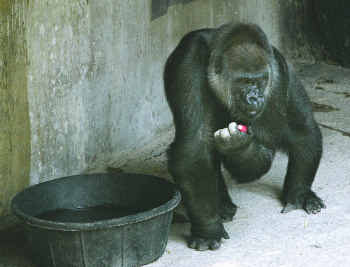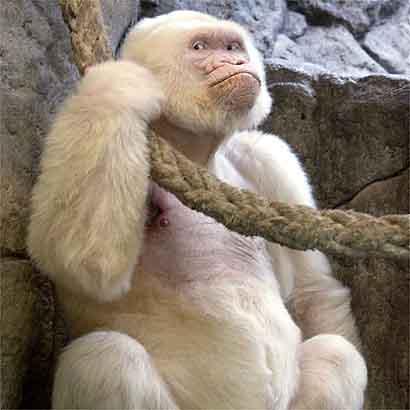
May 11, 2008

Jenny at 55. Photo by Tony Gutierrez/AP.

Jenny at 52. Photo by Jim Mahoney/Dallas Morning News.
Before gorillas were discovered, they were cryptids. Now one of the oldest non-human primates among us has reached an age milestone.

Gorillas, still rare in the wild, are more so in captivity. But it takes a special one to be noticed. For example, the world’s only captive albino gorilla, Snowflake (above) died from skin cancer in 2003. Snowflake lived beyond 40 years old; most male gorillas only live to be about 25 in the wild, although some female gorillas have a life expectancy of 60 years in zoos. He was the main attraction at the Barcelona Zoo in Spain.
Now comes word from Dallas that the gorilla recognized as the world’s oldest in captivity celebrated her 55th birthday on May 9th, by munching down a four-layer frozen fruit cake and banana leaf wrapped treats.
Jenny’s caretakers at the Dallas Zoo say she’s having a few joint issues and her eyesight isn’t what it used to be but she still looks good for an old ape.
“It’s a special milestone for us,” said Todd Bowsher, curator of the zoo’s Wilds of Africa exhibit. “It signifies that we’ve made great strides in veterinary care, nutrition and animal husbandry.”
The International Species Information System, which maintains records on animals at 700 institutions around the world, said Jenny is the oldest gorilla in its database.
“I think it’s amazing,” said Kristen Lukas, curator of conservation and science at Cleveland Metroparks Zoo in Ohio and the gorilla species survival plan coordinator for the Association of Zoos and Aquariums. “I think it’s a testament to the good care that she’s received at the Dallas Zoo and also the resilience of gorillas in general.”
Lukas said gorillas in the wild normally would live to age 30 or 35. Health care and protection from predators has extended the lifespan in zoos.
Of the roughly 360 gorillas in North American zoos, only four are over the age of 50. All of them are female. In addition to Jenny, Lukas noted Trudy at the Little Rock Zoo in Arkansas, Colo at the Columbus Zoo in Ohio and Helen at the Louisville Zoo in Kentucky.
Jenny gave birth in 1965 to a female named Vicki, who was sent to Alberta, Canada, at age 5. Zoo officials don’t know any more about Vicki. They aren’t sure why Jenny hasn’t conceived again.
Jenny’s keepers describe her as very sweet though a little bossy.
“If she doesn’t want to go out on a certain day, she doesn’t,” Bowsher said. “But she really likes people.”
There were plenty of them at the Jake L. Hamon Gorilla Conservation Research Center Thursday, chowing down on giant sheets of chocolate and vanilla birthday cake as they peered at Jenny through the glass.
When keepers set out Jenny’s berry-topped frozen cake in a forested clearing, she slowly approached. She scooped up the fruity treat with her right hand, dug into the middle of it with her left then sat down to savor the tasty yogurt-covered remains.
At one point she stood, turned her backside to the phalanx of photographers and cameramen then lumbered off to enjoy her meal in peace. She wasn’t about to share with her primate peers.
“It’s pretty amazing that the zoo where we live has the oldest gorilla that’s known,” said 8-year-old Ben Deming as he stared at Jenny.
Born in the wild of western central Africa in 1953, the exact date of her birth is unknown. Jenny lived with a family on the Cape Verde islands before the Dallas Zoo acquired her in 1957.
“I remember the day she arrived,” said Nancy Hamon, 89, of Dallas, whose family bought the gorilla for the zoo and continues to be among its strongest supporters.
Jenny, a 213-pound Western lowland gorilla, is one of four gorillas at the zoo.
“It’s a good time for the zoo,” said Sean Greene, director of Community Relations for the Dallas Zoological Society.
He said the upbeat birthday party was a welcome contrast to the tragedy that occurred in 2004 when another gorilla, 13-year-old Jabari, broke out of his enclosure. The 300-pound ape went on a 40-minute rampage in which he snatched up a toddler with his teeth and attacked three other people before officers shot him.
So to what does Jenny attribute her longevity? She’s not saying. But her vegetarian diet couldn’t hurt: seeds, cereal and one of her favorites, banana peels.
About Loren Coleman
Loren Coleman is one of the world’s leading cryptozoologists, some say “the” leading living cryptozoologist. Certainly, he is acknowledged as the current living American researcher and writer who has most popularized cryptozoology in the late 20th and early 21st centuries.
Starting his fieldwork and investigations in 1960, after traveling and trekking extensively in pursuit of cryptozoological mysteries, Coleman began writing to share his experiences in 1969. An honorary member of Ivan T. Sanderson’s Society for the Investigation of the Unexplained in the 1970s, Coleman has been bestowed with similar honorary memberships of the North Idaho College Cryptozoology Club in 1983, and in subsequent years, that of the British Columbia Scientific Cryptozoology Club, CryptoSafari International, and other international organizations. He was also a Life Member and Benefactor of the International Society of Cryptozoology (now-defunct).
Loren Coleman’s daily blog, as a member of the Cryptomundo Team, served as an ongoing avenue of communication for the ever-growing body of cryptozoo news from 2005 through 2013. He returned as an infrequent contributor beginning Halloween week of 2015.
Coleman is the founder in 2003, and current director of the International Cryptozoology Museum in Portland, Maine.
Filed under Breaking News, Classic Animals of Discovery, Cryptotourism, CryptoZoo News, Cryptozoologists, Cryptozoology, Weird Animal News